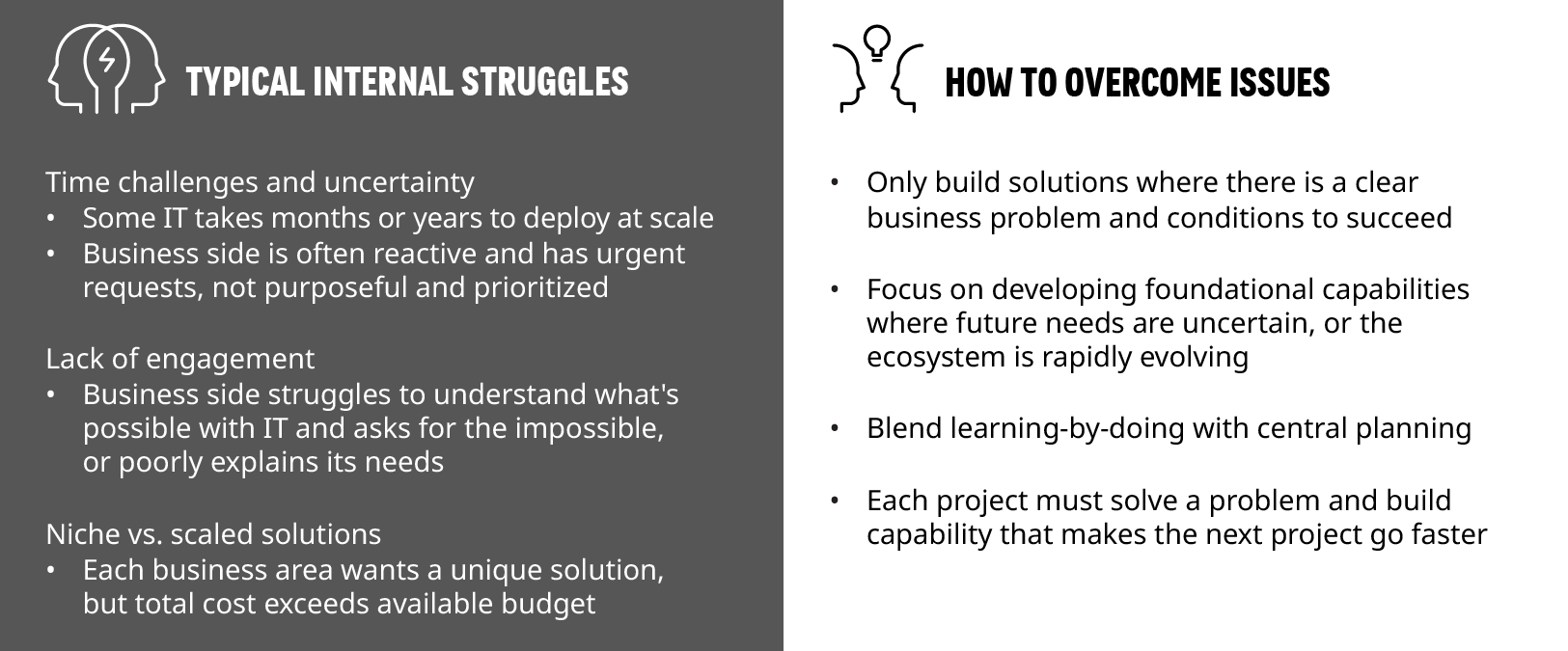Editor’s note: This is part of a series on change management.
John Kotter famously originated an eight-step process for change management. It implores leaders to create a sense of urgency, engage in effective communication, and remove barriers, among other things. Another linchpin in the framework is developing a vision for change — explaining how and why things will be different is essential to getting buy-in.
Adopting these principles is especially vital when organizations are rolling out a new technology platform or digital tool. Organizations must look beyond the tactical deployment and embrace the idea of cultural and operational change. In other words, don’t lose sight of the human element. Failing to do so will not only jeopardize the successful launch of a new system but it will contribute to a lingering resistance among disaffected groups to embrace change.
Healthcare has had a bumpy road in this regard. A lot of technology rollouts occur without internal support or a clear strategic vision. Electronic health records are a prime example. Early implementations centered around fulfilling regulatory requirements and avoiding payment penalties, not improving clinician workflow. There was a check-the-box mentality. As a result, doctors and nurses devised numerous workarounds for systems that had a bad user experience. That attitude showed up in study after study, many of which suggested that poor EHR usability contributed to clinician burnout, including a KLAS Research survey in which 35% of respondents said they would consider leaving an organization due to dissatisfaction with EHR implementation and training.
Slightly better was the rapid deployment of telehealth during the early days of the COVID-19 pandemic. Faced with unprecedented shutdowns of non-emergency procedures, health systems pivoted to telehealth. Adhering to one of Kotter’s key principles, a sense of urgency was felt throughout the industry. Most leaders articulated a clear rationale and removed organizational barriers to hasten the rollout of telehealth. And utilization soared, by as much as 154% when comparing the last week of March 2020 to the same period in 2019. Physicians were largely positive in their reviews, saying telehealth allowed them to provide high-quality care and meet patients’ needs.
Embracing Change
While the surge in telehealth was largely viewed as a positive, the challenge for healthcare leaders is sustaining its usage and building it into the business model going forward. The same can be said for a host of digital advances, including remote monitoring, artificial intelligence, machine learning, patient-generated data from health apps, interoperability, and more.
Although the business models are different, healthcare could take a page from retailers on how to effectively manage change and position themselves for the future. One prime example is the explosion in curbside pickup. The offering was in the nascent stages before the pandemic but quickly become a mainstay of operations, with companies realizing the change created more touchpoints for customers. Modeling some of Kotter’s driving principles like sustaining acceleration and generating short-term wins, retailers embedded the necessary technology, redesigned workflows, and reimagined storefronts. They recalibrated their distribution systems to account for how products are warehoused and they engaged staff in understanding how to meet new customer expectations, even if that meant limiting interactions with customers, as specialty retail CEO Mark Cosby describes in this interview with Oliver Wyman’s retail practice:
“(W)e also know that we have to make it easier for customers, so solutions such as curbside pickup where people don’t even come into the store have become important. We're looking at things like ‘shop and scan’ where a customer doesn't even have to wait in line. They come in, use their phone, scan the item, you check them at the door, and they walk right out,” he said.
To be sure, healthcare faces some hindrances, including an outdated reimbursement model. And the industry is highly fragmented with multiple stakeholders utilizing multiple platforms to collect immense amounts of data. But those factors shouldn’t prevent leaders from embracing a change management mindset. Overcoming those limitations can only be done effectively if change management is embedded in the corporate culture.
The takeaway from leading-edge companies is that reinvention takes more than developing and deploying a new technology or service, it requires a redefinition of a firm’s business model with change management underlying the pivot. True change management takes commitment from everyone, starting at the top; a change management philosophy must be embedded in the corporate culture and tied to a strategic vision.

It’s a journey, not a sprint
Before beginning a change management journey, leaders should ask some critical questions about how technology plays into broader business strategies and the business model as a whole.
Additionally, leaders need to think through the people part of the equation. Behavior change must be addressed on the front end if the goal is to alter how people act or perform work. An executive sponsor who will hold others accountable is a vital part of this process; their role and responsibilities should be written into policy so they are accountable as well. At the team level, a point person should lead the effort, relying heavily on measurable and actionable indicators.
5 Essentials of Change Management
Additional change management levers companies can pull include:
- Clearly defined policies and procedures that will guide the project
- Connecting with relevant departments early to ensure that standards and needs are being met. For instance, if launching a new service on a patient portal, include someone who works on customer experience
- Consider and measure workload. Adding on too much change at one time can be overwhelming and add to burnout, as was the case with EHRs
- Commit resources to maximize a program's success rather than containing resources and making compromises
- Create cross-functional incentive structures. Technology deployments that occur in silos and perpetuate legacy operating models are a recipe for failure. That team across disciplines must understand the rationale for change and see how it benefits the entire organization.
The current economic climate, staffing shortages, increased competition, and uncertainty that the future holds, necessitates that healthcare organizations be more thoughtful in how they deploy digital tools. The industry is littered with failed or poorly designed implementations. And even in instances where technology is engrained in operations, organizations and consumers are not receiving the full benefit. Reaching those heights takes a cultural shift in how we approach digital transformation.
Future articles in this series will spell out steps organizations can take to reinvent themselves, and sustain change, as well as how to set benchmarks to assess a project’s success.
Oliver Wyman’s Chris DeBrusk and Adam Harpool contributed to this article.
To learn more contact Matthew Weinstock, Senior Editor, Health and Life Sciences.


